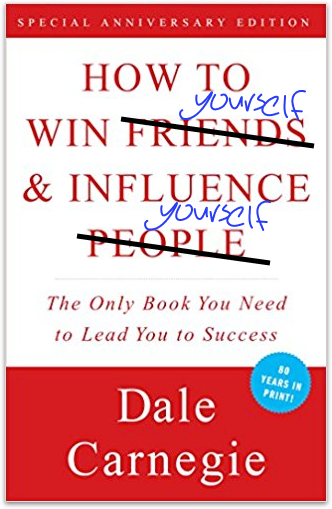
Dale Carnegie’s How to Win and Influence People (1936), the quintessential self-help book, has sold over 30 million copies. To summarise 300 pages, business mogul Carnegie basically offers endless anecdotes showing how being a kind, present person, makes people like you.
While Carnegie’s overall message may echo general virtues, the undertone of the title is one of manipulation.
Make people like YOU.
Self-help 101: entice the reader with a hook.
The hook is almost always targeted to our core beliefs. In the words of American Zen master Joko Beck, “Our core beliefs make us slaves”1.
Our core beliefs are some version of ‘I am not good enough’ or ‘I am wrong’. Thoughts creating an insatiable feeling of lack created during the genesis of our self. Selves that learned to receive love as conditional. Conditioned on looks, achievements, or comparative value. Beliefs that offer bittersweet solace for the (false) reality of separation.
We are slaves to our core beliefs, because on some level they were primary in our survival after we learned to believe that love ought to be earned.
This hook is the perfect because it ensnares within an endless pursuit. A lack that creates the motivation for a chase that has no end because it had no beginning. An insatiable hunger for the carrot that hangs before our eyes yet dangles forever out of reach.
Once you know the hook, it is time for some healthy brainwashing. Washing the brain, more like a car wash. Less like a cult.
Healthy brainwashing is the final step of the self-help journey. This last step is the same as the first because it is subtly motivated by a want for something better.
Often this comes after greater insight into our core beliefs. This may be forced upon oneself due to some unfortunate or unforeseen circumstance. Or dissatisfaction of another empty pursuit becomes fertile ground for deeper inspection.
What is different in healthy brainwashing is seeking balance over perfection. Practicing returning rather than progressing.
Neuropsychologist Allan Schore uses the model of the lateralised brain hemispheres to represents this rebalancing. Schore notes how the left brain is related to conscious processes including communication and cognition, while the right brain is related to unconscious processes including affective and relational functions2.
The right and left hemispheres, therefore, represents two completely different modes of being. The self-image of the left brain is consciously maintained and involves the story of our self, our past and future hopes and fears. However, this self-image interacts and is fashioned by the unconscious feelings and feared inadequacies in the right brain3.
In fact, the process of successful psychotherapy has been shown to correlate with ‘Right-to-Right’ hemisphere communication. When our unconscious, relational selves are activated, sometimes by connection to another present self, the obsessive self that is related to left-hemisphere activity is ameliorated and balanced. In Schore’s words, therapy creates an environment of ‘intersubjectivity’, a state nonverbal communication that correlates with specific right brain activity as well as affect regulation2.
It is easy to relate to the dichotomous modes of being by observing our own experience. It is the right brain, a state of ‘unconscious self’ or indeed ‘non-self’, and present moment connection, that seems to echo our experiences of flow, presence and connection to others and nature.
If you have had the insight in experience noticing the difference between ‘left’ and ‘right’ modes of being, you may note that the ‘left-brain’ activity is exemplified in our technology and the ability to communicate verbally within grammatical logic and structure. However, it is less useful when we seek contentment, especially when the noisiness of self-obsession obscures the completeness of stillness.
Self-help ends the moment you realise that the core of your problems, on some fundamental level, is the story of the self. Of course, tips and tricks for bettering oneself in more specific ways can be helpful. But at the core, it is often changing how you relate to yourself and the world around, and therefore altering the story of your self.
The spiritual solution to suffering has always been to connect beyond a sense of self. Most religions have metaphors and stories that emulates the power of surrender. The meditative traditions have a practicable method of observing and connecting to awareness beyond a conditioned sense of self.
You can practice this now. Sit in stillness. Follow your breath or focus on one spot. And notice how quickly your focus shifts from the breath or a spot to a story about yourself. Perhaps it is thoughts about what you are going to do for the rest of your day. Or what happened yesterday. Making ‘left’ brain decisions for moments that have not yet arrived.
And then notice what it is like to come back to your point of focus. In this shift, you are deciding to move away from left-brain activity and let go of the story of the self.
If you are like me, this will be difficult. It has taken me a long while to see that this decision is a gentle vote for wellbeing. It is partly a faith that moving away from self-obsession will improve - or better put - defragment the wholeness of my present moment experience.
Shifting the focus away from the stories we tell ourselves about ourselves is a type of radical therapy, uprooting the weeds at the base rather than the stalk.
References:
1- Beck, C. J. (2009). Everyday zen. HarperCollins.
2- Schore, A. (2022). Right brain-to-right brain psychotherapy: recent scientific and clinical advances. Annals of General Psychiatry, 21(1), 46.
3- Joseph, R. (2013). The right brain and the unconscious: Discovering the stranger within. Springer.